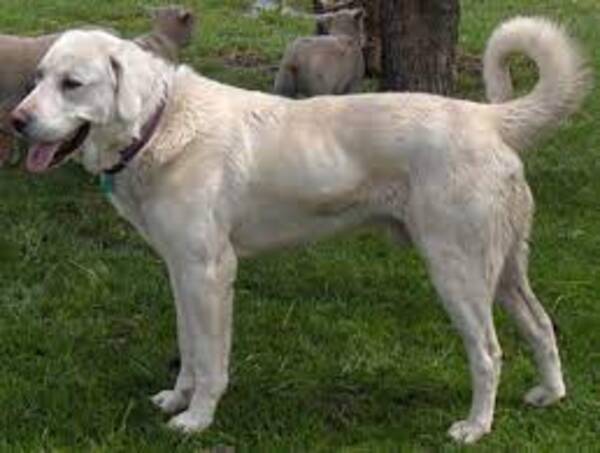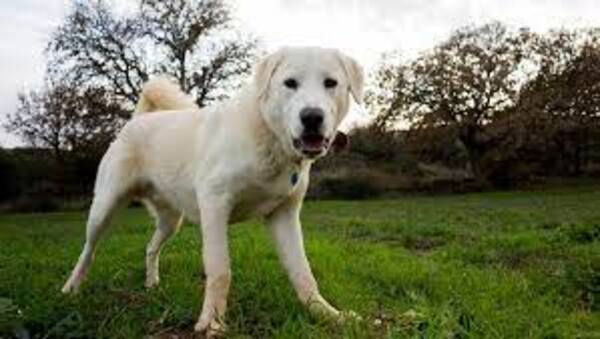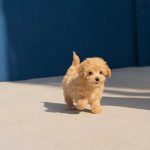Although they get along well with kids, Akbashes require early socialization if they will share a home with other dogs or animals. The Akbash might be the ideal dog for you if you want a devoted companion who will love you no matter what. We will introduce this kind of puppy from several aspects.
Akbash Dog
The Akbash dog is a big, strong dog. Weights can range from 80 to 140 pounds (36 to 63 kilograms), with sizes ranging from 28 to 34 inches. The males are obviously on the larger side of the scale.
These canines are primarily white with a possible hint of a “biscuit” color, especially on the head. The shepherds have chosen white livestock guarding dogs because they blend in with the flock and prevent the shepherds from mistaking them for predators, the majority of which are dark.
Long or short coats are both double coated and have a high shedding rate. Longer hair is on the tail and the backs of the legs, and the coat may have a wave to it. Although they are cropped in some nations, natural ears hang down.
These white dogs are not albinos; instead, they have dark pigmentation around their eyes, noses, and mouths. Like Great Pyrenees and Briards, many Akbash dogs are born with double dewclaws on their hind legs. These are large dogs, but despite their size, they are surprisingly quick and agile. Their backs exhibit a slight arch, which provides some insight into how quickly they run.
History
The Akbash dog was created in Turkey to guard livestock. There have been reports of these big guard dogs since between 750 and 300 B.C.C. According to many accounts, the dogs wore spiked collars to defend their necks when engaging in combat with predators.
It’s conceivable that a variety of dog breeds, from mastiffs to sight hounds, contributed to their design because they emerged in a crucial hub of early civilization.
Flock guardians are made to form strong bonds with the flocks they call home, which could include anything from kids to goats or sheep. Because they must frequently work without human assistance or direction, they have a tendency to be independent.
They have keen hearing and vision, and they are very aware of their surroundings. Many of these dogs serve as service and assistance dogs in addition to guarding livestock both domestically and abroad.
Personality
Always keep in mind that these dogs were chosen to be watchful and protective. Akbash dogs were frequently left to manage their flocks without human supervision and make their own decisions.
Because of their independence, they can be more challenging to train and need a firm but gentle hand to become good family pets. These dogs may be more prone to excessive “alarm barking” due to their guarding tendencies. Attempting to stay warm or cool while working is comparable to digging.
The Akbash dogs may not always get along with other dogs they have not grown up with because they see them as “predators” approaching their flock (family). They become very protective if raised with kids or other animals.
Using Akbash dogs’ independence, protectiveness, and strong bonding traits to help disabled people, at least one assistance and service dog organization selected them as their preferred breed.

Living
Akbash dogs are “easy keepers” because they have a working history and can maintain their fitness on a limited diet. Because of their thick coat, they do need regular grooming—at least once per week, and possibly more during shedding. Although these dogs weren’t bred to run nonstop, they would patiently sit on a hillside and watch their flock if they didn’t get enough daily exercise. Akbash puppies require more exercise than adult dogs do.
Despite being in generally good health, Akbash dogs still need regular maintenance and preventive care. When choosing one of these dogs as a family pet, keep in mind their history. Akbash dogs must be properly socialized and trained from a young age because they take their duty of guarding seriously.
Health
Due to their distant relationship with the Mastiff breed, the Akbash breed is more susceptible to some of the same ailments. While the majority of dogs are generally healthy, some may be more prone to a few health problems. For this reason, it’s critical to maintain proper care and regular veterinary checkups.
Some of the more common health problems the Akbash suffer from include:
- hip dysplasia
- hypothyroidism
- dilated cardiomyopathy
- gastric torsion (bloat)
Care
Like all dogs, you should keep up with your Akbash’s routine medical exams to catch any health issues early. Creating a routine for your dog’s care can be assisted by your veterinarian.
Akbashes are prone to gaining weight, especially given their low levels of energy. Make sure your dog gets at least one healthy 30- to 60-minute walk, along with some enjoyable, active playtime and shorter walks, every day.
Every day, check their ears for dirt and insects and clean them according to your veterinarian’s instructions. Once or twice a month, you should trim your dog’s nails to prevent them from growing too long. They shouldn’t be clicking against the ground. Your groomer can assist you with this.
Maintaining your Akbash’s oral health will be another issue when it comes to his or her care. Given that many dogs are prone to dental problems, you should brush your dog’s teeth as your veterinarian advises. On how to properly brush your dog’s teeth, ask your veterinarian for advice.
Feeding
A large breed with low energy needs a diet designed specifically for Akbash dogs. You should follow a regular feeding schedule and avoid leaving food out during the day because due to their lack of energy, they have a propensity to put on weight if overfed. Do not give them too many treats.
Like all dogs, the Akbash’s nutritional requirements will change from puppyhood to adulthood and then again as they get older. Because there is too much variation among individual dogs—including in terms of weight, energy level, and health—to make a specific recommendation, you should ask your veterinarian for advice regarding your Akbash’s diet.
Training
The Akbash breed and family place a high value on training. To take charge, the breed requires a strong leader. You don’t have to be violent or employ any cruel training methods, but you do need to be assertive and in charge.
You need to be confident throughout training, know what you want, and have a plan for how to get it. If you think you’re not fully in control, the Akbash might start to disregard your training.
Socialization needs to begin when your dog is only a few months old and should be viewed as a component of training as well. Early socialization should focus on exposing your dog to novel and unusual situations and people because this breed is known for being wary of and potentially aggressive toward strangers.
In addition to introducing the dog to people, this demonstrates how to treat unusual situations when they arise.





